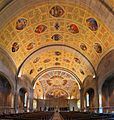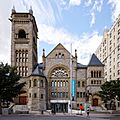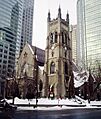List of National Historic Sites of Canada in Montreal facts for kids
Montreal is a city full of amazing history! Did you know it has many special places called National Historic Sites? These are places that tell important stories about Canada's past. As of 2018, there are 61 of these sites right here in Montreal and nearby areas. Four of them, like the Lachine Canal, are even looked after by Parks Canada, which is Canada's national park service. You can spot these by a little beaver icon ![]() ! The very first site chosen in Montreal was the old village of Hochelaga way back in 1920.
! The very first site chosen in Montreal was the old village of Hochelaga way back in 1920.
These special sites are chosen by the Historic Sites and Monuments Board. Their names might be a bit different from what you usually hear, but they all mark a piece of Canada's amazing story.
Discovering Montreal's Historic Places
Montreal is home to many incredible National Historic Sites. Each one helps us understand the city's past, from ancient villages to grand buildings and important battlegrounds.
Buildings with Cool Stories
Montreal has many old buildings that are now historic sites. They show us different styles of architecture and how people lived long ago.
Libraries and Banks
- Atwater Library (Designated: 2005): This building, finished in 1920, was home to Canada's first Mechanics' Institute. It's the oldest library of its kind in Canada that still serves its original purpose.
- Bank of Montreal (Designated: 1990): Completed in 1894, this sandstone building is a rare example of the Queen Anne Revival style in Canada. It was once a busy bank branch.
Grand Homes and Mansions
- Château De Ramezay / India House (Designated: 1949): Built in 1705, this stone mansion was home to the Governor of Montreal. It played a big role in the politics and trade of New France and Lower Canada for two centuries.
- Ernest Cormier House (Designated: 2018): This unique house was designed by famous architect Ernest Cormier for himself in 1930-31. Later, it became the home of former Prime Minister Pierre Trudeau.
- George Stephen House / Mount Stephen Club (Designated: 1971): This large Victorian mansion, finished in 1881, is a great example of Renaissance Revival architecture. It belonged to George Stephen, 1st Baron Mount Stephen, who was important in the Bank of Montreal and the Canadian Pacific Railway.
- H. Vincent Meredith Residence (Designated: 1990): Built in 1897, this mansion shows the grand homes of Montreal's wealthy families. It's a good example of the Queen Anne Revival style and is now part of McGill University.
- Louis-Joseph Papineau
 (Designated: 1968): This stone house, built in 1785, was the Montreal home of the Papineau family. It's linked to Louis-Joseph Papineau, a key leader in the Lower Canada Rebellion.
(Designated: 1968): This stone house, built in 1785, was the Montreal home of the Papineau family. It's linked to Louis-Joseph Papineau, a key leader in the Lower Canada Rebellion. - Maison Cartier (Designated: 1982): These two stone houses, built in 1813, show how homes were constructed in Canada before big industries.
- Monklands / Villa Maria Convent (Designated: 1951): This two-storey stone mansion, finished in 1804, was the official home for Canada's Governors General from 1844 to 1849.
- Sir George-Étienne Cartier
 (Designated: 1964): These two houses were the home of Sir George-Étienne Cartier, one of the Fathers of Confederation. They show what an upper-middle-class Montreal home looked like in the mid-1800s.
(Designated: 1964): These two houses were the home of Sir George-Étienne Cartier, one of the Fathers of Confederation. They show what an upper-middle-class Montreal home looked like in the mid-1800s. - Van Horne / Shaughnessy House (Designated: 1973): This mansion, built in the Second Empire style, belonged to Thomas Shaughnessy, 1st Baron Shaughnessy. Today, it's part of the Canadian Centre for Architecture.
Churches and Religious Sites
- Christ Church Cathedral (Designated: 1999): Finished in 1860, this cathedral is a great example of Gothic Revival style. Many important Montreal leaders were part of its congregation.
- Church of Notre-Dame-de-la-Défense (Designated: 2002): This Romanesque Revival church in Montreal's Little Italy was built specifically for the Italian Canadian community. It's linked to Canada's oldest Italian community.
- Church of Saint-Léon-de-Westmount (Designated: 1997): Completed in 1903, this church is known for its amazing mural decorations. It's one of the few places in Canada with art done using the buon fresco technique.
- Erskine and American United Church (Designated: 1998): This large Romanesque Revival church, finished in 1894, has beautiful stonework and unique windows. It holds the largest collection of Louis Comfort Tiffany's religious stained glass windows in Canada.
- Marie-Reine-du-Monde Cathedral (Designated: 1999): Consecrated in 1894, this Baroque Revival cathedral was inspired by St. Peter's Basilica in Rome. It was a new style for Montreal at the time.
- Notre-Dame Roman Catholic Church / Basilica (Designated: 1989): This huge stone church, completed in 1829, was the largest church in Canada or the U.S. for 50 years. It's a key example of the Gothic Revival style in Canada.
- Saint Joseph's Oratory of Mount Royal (Designated: 2003): This large Roman Catholic pilgrimage site, established in 1904, is famous for its huge domed basilica. It was started by André Bessette and is now a major religious and tourist spot.
- Saint-Sulpice Seminary and its Gardens (Designated: 1980): Completed in 1687, this religious seminary and its garden are rare examples of French Regime classicism.
- St. George Antiochian Orthodox Church (Designated: 1999): Finished in 1940, this church is mostly in the Byzantine style. It's the oldest church built specifically for the Syrian Orthodox community in Canada.
- St. George's Anglican Church (Designated: 1990): This Anglican church in downtown Montreal, completed in 1870, is a great example of the High Victorian phase of the Gothic Revival style.
- St. James United Church (Designated: 1996): This large stone church, finished in 1888, is in the High Victorian Gothic Revival style. It's known for its unique interior design.
- St. Patrick's Basilica (Designated: 1990): Completed in 1847, this church is a notable example of French Gothic Revival architecture. It was built for the many Irish immigrants who came to Montreal.
Other Important Buildings
- Bonsecours Market (Designated: 1984): This huge, domed building, finished in 1847, was originally Montreal's first city hall, a public market, and a concert hall. It showed Montreal's growth as a big city.
- Former Montreal Custom House (Designated: 1997): Completed in 1838, this building is an excellent example of Palladian architecture in Canada. Its construction marked Montreal's growing importance.
- Grey Nuns' Hospital (Designated: 1973): This building, finished in 1765, is an example of early French Canadian architecture. The Sisters of Charity cared for the sick here and later expanded their work across Canada.
- Hersey Pavilion (Designated: 1997): Built in 1905, this was one of Canada's first buildings made specifically for nurses to live in. It shows the history of nurses in Canada.
- Montreal City Hall (Designated: 1984): This five-storey stone building, finished in 1878 and rebuilt in 1922, is a top example of the Second Empire style. It was the first city hall in Canada built only for city government.
- Monument National (Designated: 1985): This four-storey theatre and cultural center, completed in 1893, was known as the "Heart of French America." It's now home to the National Theatre School of Canada.
- Mother House of the Grey Nuns of Montreal (Designated: 2011): This former main building of the Grey Nuns, finished in 1871, is now part of Concordia University. It's important for its architecture and the social work done by the nuns.
- Marlborough Apartments (Designated: 1990): This four-storey brick apartment building, completed in 1900, is a great example of early 20th-century apartment design in Canada.
- Masonic Memorial Temple (Designated: 2001): This grand temple, finished in 1930, looks like a Greek temple. It was built to honor Freemasons who served in the First World War.
- Outremont Theatre (Designated: 1993): This cinema, completed in 1929, has an Art Deco exterior and a unique interior. It's a great example of the fancy cinemas built in new neighborhoods in the 1920s.
- Pavillon Mailloux (Designated: 1997): This five-storey brick building, finished in 1931, was a residence for nurses at Montreal's Notre-Dame Hospital. It shows the growing importance of nursing.
- Rialto Theatre (Designated: 1993): This movie palace, completed in 1924, is an exceptional example of Beaux-Arts architecture in Canada.
- Roger Gaudry Building (Designated: 2018): This large, unique building and tower at the University of Montreal was built by Ernest Cormier from 1928-1943. It's a symbol of Quebec's support for education.
- Sulpician Towers / Fort de la Montagne (Designated: 1970): These two 13-meter towers, finished in 1694, were once part of a fort built by the Sulpicians. They also housed the school of Marguerite Bourgeoys.
- Wilson Chambers (Designated: 1990): This four-and-a-half-storey stone building, completed in 1868, is a rare example of Gothic Revival style used for a commercial building in Canada.
- Windsor Station (Canadian Pacific) (Designated: 1975): This railway station and head office for the Canadian Pacific Railway was finished in 1889. It's one of the first major buildings in Canada to use the Richardsonian Romanesque Revival style.
Important Places in History
Some historic sites mark important events or areas that shaped Montreal and Canada.
Battle Sites
- Battle of Rivière des Prairies / Battle of Coulée Grou (Designated: 1924): This site marks a battle in 1690 between Iroquois and French settlers.
- Battle of the Lake of Two Mountains (Designated: 1925): This skirmish in 1689 between French coureurs de bois (fur traders) and Iroquois helped French settlers feel more confident after the Lachine massacre.
Canals and Trade Routes
- Lachine Canal
 (Designated: 1929): This 14-kilometer canal, finished in 1825, was built to help boats get around rapids on the St. Lawrence River. It was a key part of a network linking the Great Lakes to the Atlantic Ocean.
(Designated: 1929): This 14-kilometer canal, finished in 1825, was built to help boats get around rapids on the St. Lawrence River. It was a key part of a network linking the Great Lakes to the Atlantic Ocean. - Lachine Canal Manufacturing Complex (Designated: 1996): This area along the Lachine Canal was a huge industrial center. From 1880 to 1940, it had more factories and produced more different goods than anywhere else in Canada.
- LeBer-LeMoyne House (Designated: 2002): This 17th-century stone building, completed in 1671, was an early fur trading post. It's one of the oldest buildings linked to the fur trade during the French Regime.
- Sainte-Anne-de-Bellevue Canal
 (Designated: 1929): This canal, completed in 1843, helped boats bypass rapids on the Ottawa River. It shows how important waterways were for travel and trade in the 1800s.
(Designated: 1929): This canal, completed in 1843, helped boats bypass rapids on the Ottawa River. It shows how important waterways were for travel and trade in the 1800s. - The Fur Trade at Lachine
 (Designated: 1970): This stone warehouse, finished in 1803, was built by the North West Company. It represents the important history of the fur trade in Montreal.
(Designated: 1970): This stone warehouse, finished in 1803, was built by the North West Company. It represents the important history of the fur trade in Montreal.
Cemeteries and Gardens
- Last Post Fund National Field of Honour (Designated: 2007): Established in 1930, this military cemetery is for veterans. It stands for the idea that all soldiers are equal in death and should be remembered forever.
- Montreal Botanical Garden (Designated: 2008): This 75-hectare botanical garden, established in 1931, is one of the most important botanical gardens in the world because of its amazing plant collections.
- Mount Royal Cemetery (Designated: 1999): This 67-hectare cemetery, established in 1852, is on the side of Mount Royal. Many of its monuments are historically and artistically valuable, reflecting Montreal's history.
- Notre-Dame-des-Neiges Cemetery (Designated: 1999): Established in 1854, this is the largest cemetery in Canada. It's a significant cultural landscape and holds the graves of many people important to Montreal, Quebec, and Canada.
Other Significant Locations
- Black Watch (Royal Highland Regiment) of Canada Armoury (Designated: 2008): Completed in 1906, this building is home to The Black Watch (Royal Highland Regiment) of Canada, one of Canada's oldest regiments. It shows the important role of military armouries.
- Hochelaga (Designated: 1920): This grass-covered area marks the site of the Iroquois village of Hochelaga. Jacques Cartier, the first European to visit Montreal, saw this village in 1535.
- Maison Saint-Gabriel (Designated: 2007): This stone house, finished in 1668, was home to the sisters of the Congregation of Notre Dame. They ran a farm here for over 300 years, making it one of Canada's oldest surviving farm properties.
- Merchants Textile Mill (Designated: 1989): Established in 1882, this was the second-largest textile mill in Canada for the first 40 years of the 20th century.
- Model City of Mount Royal (Designated: 2008): This historic neighborhood, planned in 1914, mixes different city planning ideas like the City Beautiful and Garden City. It's very consistent in its design.
- Montreal Forum (Designated: 1997): Completed in 1924, this is one of Canada's most famous sports venues. It's an icon of Canadian culture because of its link to the Montreal Canadiens hockey team.
- Montreal's Birthplace (Designated: 1924): This is the exact spot where Paul Chomedey de Maisonneuve founded Montreal (as Fort Ville-Marie) on May 18, 1642.
- Senneville Historic District (Designated: 2002): This 565-hectare historic area developed from a late-19th-century resort village with country estates of wealthy Montrealers. It shows the development of Picturesque landscape design and Arts and Crafts architecture.
- The Main (Designated: 1996): This 6-kilometer stretch of Saint Laurent Boulevard was where many immigrant groups settled over time. The mix of cultures here has inspired many artists.
- Westmount District (Designated: 2012): This historic district, incorporated as a city in 1874, shows the architectural styles and landscape design trends from 1890 to 1930. It reflects efforts to protect the area's unique history.
Images for kids
-
Plan of "Model City" and Mount Royal Tunnel
See also
- List of historic places in Montreal
- History of Montreal
- Architecture of Montreal




























































